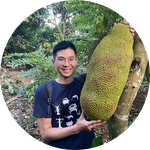About This Project
Larimichthys crocea was one of China's three top commercial marine fishes. However, heavy fishing pressured lead to a rapid 90% decline in population by the 1980s, with the species now listed as critically endangered. Hong Kong’s L. crocea population status is currently unknown, though it has been documented by local fishermen. In this study, we collect fish eggs and eDNA water samples to determine the spatiotemporal spawning ecology to aid future local sustainable management plans.
Ask the Scientists
Join The DiscussionWhat is the context of this research?
During the 1950s and 1980s, Larimichthys crocea was a key China fisheries species, ranking in the top three for marine fisheries production. However, due to the heavy fishing exploitation, the wild population declined by over 90% by the 1980s, becoming a rare bycatch species (Liu & Sadovy de Mitcheson 2008), and was classified as critically endangered. Past management practice showed that the closing of the spawning season could improve its reproductive output and fishery catch. However, the current state of Hong Kong's population is largely unknown limiting management action plans. The key question I am trying to answer is where and when L. crocea spawn in Hong Kong waters. To achieve these goals for current and future assessments, non-invasive sampling methods will be utilized.
What is the significance of this project?
Currently, only 5% of Hong Kong waters are designated to be established as marine protected areas (MPA). However, this figure is lagging far behind the Global Biodiversity Framework's "30x30" target. Meanwhile, scientists, conservationists and NGOs in Hong Kong are calling for 10% of Hong Kong waters to be designated as MPA by 2030. However, the newly suggested MPA is mainly for protecting mammals, coral reefs, and horseshoe crabs, without any consideration for protecting the spawning grounds of highly valued critically endangered fishes. The goal of this project is to determine the spawning area and timing of a critically endangered species, Larimichthys crocea, in Hong Kong waters which can provide solid evidence to promote more MPA to conserve biodiversity on a fine scale.
What are the goals of the project?
To achieve the goals of this study, we identified 8 sampling sites in western Hong Kong waters which were previously determined as spawning grounds for our target species, based on reports from the 1970s. Sampling is currently underway since September 2023, and has been conducted on the second day of the high tide or full moon once per month. During sampling, 10 minutes of plankton trawl and 6 liters of middle seawater have been collected. Currently, we have 132 eDNA samples and around 2,400 fish egg samples that need to be extracted, and a relative number of qPCR and PCR that need to be conducted, respectively. The fund will be used to purchase DNA extraction kits and qPCR and PCR primers and reagents to complete the data generation from the already acquired samples.
Budget
This project is a chapter of my PhD research. This funding is critically important to help us achieve the eDNA/DNA extraction and PCR/qPCR goals in this project. In this project, we need to do field boat sampling of eight sites once per month from September 2023 to August 2024. The boating cost and transportation fees in Hong Kong are expensive which take around 13k $ USD overall for this project. In this study, we will collect 132 eDNA samples and an estimated 100,000 fish egg samples. We target to detect target species via qPCR from 132 eDNA samples and subsample 2,400 fish eggs for barcoding analysis. The project sampling period is from September 2023 to August 2024, and we plan to finish the lab work and data analysis before December 2024 and finish the paper before February 2025.
Endorsed by
 Project Timeline
Project Timeline
Monthly sampling began in September 2023 and will end in August 2024. From September 2023 through October 2024, eggs will be sorted, subsampled and DNA extracted for barcoding identification, and all eDNA samples will be extracted for qPCR analysis. We expect to obtain and analyze the data between October and December 2024 and be ready to submit the paper around February 2024.
Apr 15, 2024
Project Launched
Aug 31, 2024
Finish sample collection.
Dec 31, 2024
qPCR signals of target species fit the spatiotemporal occurrence and abundance of Larimichthys crocea in the study area.
Dec 31, 2024
Update the spawning ground and season of Larimichthys crocea in the study area.
Feb 28, 2025
Seminar of this study for scientists, government and NGOs.
Meet the Team
Team Bio
The team will be based at the Environmental DNA and Environmental Ecology Laboratory of the University of Hong Kong. The PI (Dr. Mat Seymour) is an eDNA expert and the lab have clean room and relative facilities for eDNA studies. During the project period, the team member will be meet twice a week. The team member Mat Seymour can provide from logistics, cutting-edge eDNA knowledge, eDNA extraction and qPCR protocols, and data analysis suggestions for this project.
Baian Lin
I was born in a fishing family on an island in Southern China. The island is one of the important spawning grounds of Larimichtys crocea. My grandfather told me that this species is common and they only brought back a size of 50-60 cm total length (TL) individuals when he was my age, and my father told me this species is common seasonally and they only chose a size of 30-40 cm TL individuals when he was my age. However, this species is rare and small (~20 cm TL) in my generation. Therefore, I am trying to be a marine scientist for marine conservation and fishery improvement. My study interests focus on Marine Biodiversity and Conservation, Fish and crab reproductive biology and fishery improvement. I will develop and apply molecular and traditional biology and ecology methods to understand the biodiversity and population dynamics of marine fishes for conservation.
Mat Seymour
I am a Molecular/eDNA ecologist specialized in generating and analyzing large datasets to assess the effects of environmental, temporal and spatial influences on biological communities, with direct implications to ecosystem stability, health and function. Originally from the USA I obtained my BA at the University of Wyoming, my Msc at Holar University in Iceland and my PhD at ETH in Switzerland. I have worked in government and academic research institutions in the USA, UK and Sweden before joining The University of Hong Kong. I started the eDNA and molecular ecology lab at The University of Hong Kong's School of Biological Sciences in 2022 to advance our understanding and use of eDNA for assessing ecological systems. My group overall specializes in developing and applying molecular based methods to assess trophic and biodiversity dynamics.
Lab Notes
Nothing posted yet.
Project Backers
- 3Backers
- 100%Funded
- $4,440Total Donations
- $1,480.00Average Donation

